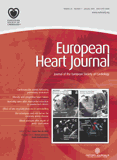-
PDF
- Split View
-
Views
-
Cite
Cite
A Vahanian, The growing burden of infective endocarditis in the elderly, European Heart Journal, Volume 24, Issue 17, 1 September 2003, Pages 1539–1540, https://doi.org/10.1016/S0195-668X(03)00344-0
Close - Share Icon Share
See doi:10.1016/S1095-668X(03)00309-9for the article to which this editorial refers
Infective endocarditis is a rare disease which still carries a severe prognosis partly because of changes in epidemiology due to the growing number of patients with a high risk profile. In this respect there is an growing proportion of elderly patients with infective endocarditis related to the increase in life expectancy in industrialised countries. As an illustration the patients over 70 represent 26% of the cases with infective endocarditis in the Euro Heart Survey on Valvular Heart Disease which was performed in 2001 (Personal communication. Tornos P. Annual Congress of the European Society of Cardiology, Berlin, August 2002). In addition, in a recent French survey the overall age- and sex- standardized annual incidence of infective endocarditis was 31 cases/million population and it significantly increased in patients over 50, and peaked at 145 cases/million between the ages 70 and 80.1Despite the importance of the problem we have little data available on infective endocarditis in the elderly, with sometimes conflicting results.2–4
The study by Di Salvo et al. in this issue of the journal5is the largest in the field since it included 87 patients aged over 70. This study provides important information due to the careful observance of diagnostic criteria, the extensive evaluation, and active management which were used in the four referral centres performing the study.
The first findings in the study show specific features of infective endocarditis in the elderly, in comparison with younger patients, as regards portal of entry and subsequent consequences on microbiology. In the elderly a digestive origin is more frequent, due to the higher incidence of colonic lesions. As a consequence Streptococci bovis is the predominant pathogen. Urologic disorders, such as prostatic or vesical diseases, are also more frequently encountered in the elderly. The high incidence of these two specific portal of entry has important implications for diagnosis and also stresses the importance of prophylactic procedures in particular during endoscopic procedures which are frequently performed in these patients. Finally, pace maker endocarditis is most often seen in older patients with the inherent difficulties in diagnosis and poor prognosis.
It is generally acknowledged that infective endocarditis may be more difficult to diagnose in the elderly due to a more insidious presentation. In this study there was no difference in the clinical presentation between different age groups and only a non-significant trend towards a more delayed diagnosis in the elderly. However previous studies have suggested that clinical features of infective endocarditis may well differ from patients in referral centres, such as those in the study, and those seen in primary care.6
It is anticipated that the early diagnosis in this study was facilitated by the large use of transoesophageal echocardiography for diagnosis since all patients underwent this examination. The higher sensitivity of transoesophageal echocardiography, compared with thetransthoracic approach, for detection of vegetation undoubtedly enables an earlier and more accurate diagnosis. The precise echocardiographic evaluation in this study shows that there was no difference according to age as regards the incidence of vegetation, abcesses, or new regurgitation.
This study provides further proof that infective endocarditis in the elderly carries a poor prognosis: the in-hospital mortality was 17% in patients over 70 compared with 10% between 50 and 70 and 7% for those below age 50. This can be explained by the higher incidence of co- morbidity in the elderly; however the multivariate analysis performed in this study showed that age per se is an independent predictor of fatality as well as prosthetic endocarditis and embolic events.
In the literature in-hospital mortality of infective endocarditis in the elderly ranges between 25 and 28%.2–4The trend towards a lower mortality in this series is probably related to the benefit of early surgery which was performed in as much as 41% of cases, which is a high figure even if it is lower than in younger age groups.
Operative mortality in this elderly population, no doubt carefully selected, was similar to that of the younger patients. On the other hand the mortality of the elderly patients who were not operated on remains high at 21%. Even if the encouraging results of early surgery are not based on a randomized comparison with follow- up data, they provide further evidence of the effectiveness of early surgery in infective endocarditis and support the use of this strategy in selected elderly patients.
Thus, several lessons for the future management of infective endocarditis in the elderly can be drawn from the study by Di salvo et al: this diagnosis should be more often considered in elderly patients, and in such cases a careful search for either digestive or urinary portal of entry should be performed; a large use of transoesophageal echocardiography will enable an early diagnosis and timely initiation of an appropriate treatment; early surgery must be carried out in selected patients; finally prophylactic measures must be largely used during urologic and digestive procedures. Such measures could decrease the incidence of infective endocarditis in the elderly and will no doubt improve its prognosis.
References



